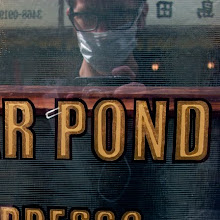Saturday, March 5, 2011
Living at VOLTA NY (Friday, environments and experiences)
I was incredibly stoked when I first heard that EVOL was showing at VOLTA NY (with Berlin's WILDE Gallery, Booth E8). I'd had the pleasure of seeing his hyperrealistic stenciled spray-paintings on found cardboard at the "Summer Invitational" group show at Jonathan LeVine Gallery (also exhibiting here in booth V6) in summer 2010, which I think was his 1st showing in NYC outside art fairs. His renderings of anonymous apartment blocs and a now demolished Dresden slaughterhouse (Caspar-David-Friedrich-Stadt) define and defy the term "photorealism", as they're only — I say "only" — layerings of dozens of stencils. The end results, thrown shadows cast against unadulterated tan GDR cardboard, vividly realized slot-windows, burned out vehicles, soaring lettering from actual graf tags or remnants of the cardboard itself (replete here and there w/ rips, tape etc), are nothing less that jaw-dropping.
Tim Okamura's stirring portraits practically breathe Brooklyn (he's showing with Lyons Wier Gallery, Booth C7). Many of his paintings are very large, painstakingly detailed oil and spraypaint compositions of figures (many of them women of color, nearly everyone a friend of Okamura's) facing you dead-on, their gaze relaxed in the middle-distance yet unwavering, like if they could they'd sharpen it and peer into your soul. His paintings are so realistic they make me miss New York City, even though I'm here at a NYC art fair staring at them — their layers of history is that palpable, just like the stained brick, the stenciled or graffiti'ed walls, the weathered stone that forms the backdrops of his subjects.
The nucleus of Galerie Anita Beckers (Booth G2) holds a glossy black-painted paving stone, displayed stoically on a stack of bricks. This is the exacting core of Florian Heinke's presentation. It's an object and a weapon, painted to elevate its artlike modus in the heads of collectors whilst maintaining its sinister presence. Hurled as a projectile, it would pierce his large-scale contrasty acrylic works, hung in dynamic succession and covered in poetic (or agitating) text and silkscreened imagery. The recurring riot figures into his composite imagery, relating back to that magnetizing paving stone. His Die Kummernis 2 (referencing St. Kummernis, a princess in 17th C. Germany totally devoted to religion, to the extent she vowed never to marry. Her father opposed this, so she prayed to grow a beard instead. Her prayer was answered, the King crucified her in a rage, and she became a saint to the people — and apparently this was in the 1st edition of Grimm's Fairy Tales!) captures this in a sexy Heidi Klum beach shot w/ a photo-manipulated beard. In fact, she looks a bit like Jesus, which echoes Die Kummernis' crucifixion (at the hands of her own father) and her symbol for women's rights. Its neighbors — "Paradise Overdosed", "The last curs fight the bricks" — draw us deeper into the ebb and flow of turmoil and peace, and even the gently innocuous portrait of a lady-friend on the balcony ("A smile that keeps summertime", and hers does indeed) carries an ominous sky, as if it's enveloped by the effluvium from burning automobiles.
Stand within Darren Foote's booth at DODGEgallery (D6) transports me to his native Idaho cattle ranch. Don't believe me? Try it for yourself. Stand next to his polished-wood slabs, stacked like Claes Oldenburg-sized Kit Kat bars and spotted all over with mirrored birdshit, a simultaneous homage to and prodding at Minimalism (think Robert Smithson's writings on rust and swap out w/ birdshit, or Carl Andre's lovely cedar blocks maligned by wear, & you're nearly there). In your line-of-sight should be an old-school slide-projector, set on a combination wood and MDF crate, perpetually ticking away Foote's some seven dozen shots of visit back to the farm, after leaving there for university (and his family subsequently selling it). The soft-edgedness of the slides, the recurring imagery of trees, nature, birdshit, it's what Foote refers to as his self-portrait, a compendium of his own history, growing up in Idaho before moving to the East Coast, then returning there again to explore the overgrown landscape. The sublime wood sculptures, like this combination of carved and sanded maple and a found maple sapling, its oddly arm-like "limb" reaching for its stonelike human neighbor (cast from the artist's own forearm), embody this intimacy with nature, memories of his time growing up in the country, memories particular to him but not so difficult for even this stalwart city-dweller to understand.





